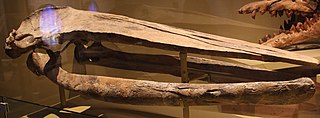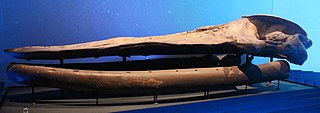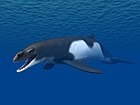
Neobalaenidae is a family of baleen whales including the extant pygmy right whale. Although traditionally considered related to balaenids, recent studies by Fordyce and Marx (2013) and Ludovic Dutoit and colleagues (2023) have recovered the living pygmy right whale as a member of Cetotheriidae, making it the only extant cetotheriid. Not all authors agree with this placement.

Cetotherium is an extinct genus of baleen whales from the family Cetotheriidae.

Aetiocetus is a genus of extinct basal mysticete, or baleen whale that lived 33.9 to 23.03 million years ago, in the Oligocene in the North Pacific ocean, around Japan, Mexico, and Oregon, U.S. It was first described by Douglas Emlong in 1966 and currently contains known four species, A. cotylalveus, A. polydentatus, A. tomitai, and A. weltoni. These whales are remarkable for their retention of teeth and presence of nutrient foramina, indicating that they possessed baleen. Thus, Aetiocetus represents the transition from teeth to baleen in Oligocene mysticetes. Baleen is a highly derived character, or synapomorphy, of mysticetes, and is a keratinous structure that grows from the palate, or roof of the mouth, of the whale. The presence of baleen is inferred from the fossil record in the skull of Aetiocetus. Aetiocetus is known from both sides of the Pacific Ocean: it was first documented in Oregon, United States, but it is also known from Japan and Mexico. The genus is currently constrained to the Northern hemisphere and has little value in biostratigraphic studies of the Oligocene due to its limited occurrences across the Pacific.
Joumocetus is a genus of extinct baleen whale in the family Cetotheriidae containing the single species Joumocetus shimizui. The species is known only from a partial skeleton found in Miocene age sediments of Japan.

Cetotheriidae is a family of baleen whales. The family is known to have existed from the Late Oligocene to the Early Pleistocene before going extinct. Although some phylogenetic studies conducted by Fordyce & Marx 2013 recovered the living pygmy right whale as a member of Cetotheriidae, making the pygmy right whale the only living cetotheriid, other authors either dispute this placement or recover Neobalaenidae as a sister group to Cetotheriidae.

Parietobalaena is an extinct genus of baleen whale, belonging to the family Pelocetidae. Fossils are found in Miocene-aged marine strata in North America, Europe, Australia, and Japan, including the Temblor and Itahashi formations. Based on previous estimates of juvenile specimens, Tsai (2017) suggested a body size of 12-15 m for P. yamaokai, akin to that of the gray whale.
Mesocetus is an extinct genus of baleen whale from the Miocene of Europe and North America.

Aglaocetus is a genus of extinct baleen whales known from the Miocene of Patagonia, the US Eastern Seaboard, Japan and the Low Countries. It was once considered a member of Cetotheriidae along with many other putative cetotheres, but was recently recognized as representing a distinct family from true Cetotheriidae.
"Balaenoptera" ryani is an extinct species of Balaenopteridae from the late Miocene of California. It was originally considered a species of Balaenoptera, but is now recognized as more primitive than any extant or fossil balaenopterid and thus in need of a new generic name.

Mixocetus is a genus of extinct baleen whale belonging to the family Tranatocetidae. It is known only from the late Miocene (Tortonian) of Los Angeles County, California.
Nannocetus is an extinct baleen whale belonging to the family Cetotheriidae.
Tohoraata is a genus of eomysticetid baleen whale from the Late Oligocene (Chattian) of New Zealand. There are two recognized species, T. raekohao and T. waitakiensis.
Eomysticetidae is a family of extinct mysticetes belonging to Chaeomysticeti. It is one of two families in the basal chaeomysticete clade Eomysticetoidea.

Tranatocetus is an extinct genus of mysticete from the late Miocene (Tortonian) of Jutland, Denmark. The type and only species is Tranatocetus argillarius.

Brandtocetus is a genus of cetotheriid mysticete in the subfamily Cetotheriinae. The type and only species is Brandtocetus chongulek from the late Miocene (Tortonian) of the Kerch Peninsula in Crimea.

Mithridatocetus is a genus of cetotheriid mysticete in the subfamily Cetotheriinae. Known specimens have been found in marine deposits in Crimea, Ukraine, and the Russian Caucasus.
Kurdalagonus is a genus of cetotheriid mysticete in the subfamily Cetotheriinae from the Miocene of the Russian Caucasus.
Eucetotherium is a genus of cetotheriid mysticete from Miocene (Tortonian) marine deposits in the Russian Caucasus.
Isocetus is an extinct genus of baleen whale belonging to the clade Thalassotherii. Remains have been found in middle Miocene marine deposits in Belgium.

Ciuciulea is a genus of cetotheriid mysticete found in middle Miocene marine deposits in Moldova.













